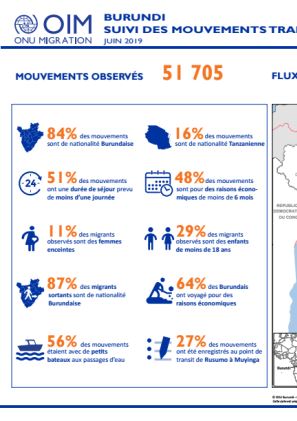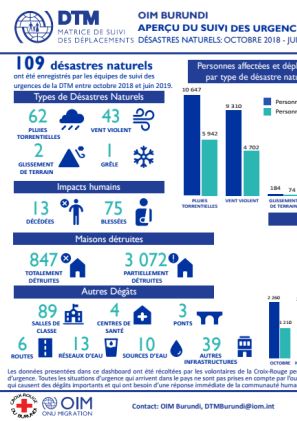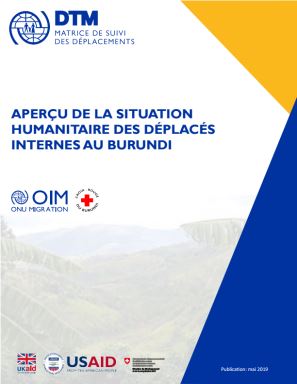-
Countries
-
Data and Analysis
-
Special Focus
-
Crisis Responses
Burundi
Burundi
Desplazados internos rastreados
Movimientos de desplazamiento
8,100
IDMC 2023
Ronda de recopilación de datos
Sobre Burundi
In response to the great need for information on internally displaced persons (IDPs), their humanitarian profile and needs, as identified by the humanitarian community and the Burundian authorities, the International Organization for Migration (IOM) implemented DTM since 2015 to effectively and systematically track and assess internal population flows in Burundi and therefore provide reliable information on the current situation of IDPs.
The Displacement Tracking Matrix monitors IDPs on a national level and to identify their humanitarian needs. The DTM’s main objective is to maintain a comprehensive system of data collection and sharing on IDPs. The project relies on the synergy between IOM's DTM and the Burundi Red Cross (BRC), who are jointly responsible for data collection on internally displaced persons. The collected data includes figures on displacement, as well as displacement centres, provenance locations, approximate duration of displacement and humanitarian needs of the displaced populations. The information collected at various levels contributes to the construction of an overall profile of the displaced population in targeted provinces, which can then be used by the government and the humanitarian partners in order to protect, assist and advocate for IDPs.
In November 2018, DTM Burundi also began to collect data on movement at unofficial points of transit on the Burundi - Tanzania border. The information collected at the flow monitoring points enable the government, humanitarian partners and policy stakeholders, to understand migration trends on the national and regional levels.
Contacto
DTMBurundi@iom.int
Current Donors
- PRM
- BHA
- Japan
- Republic of Korea
- Swiss (SDC)
Para obtener resultados de búsqueda más avanzados, vaya a la Página de búsqueda avanzada de informes
Burundi — Flow Monitoring Report — July 2019
Flow Monitoring is a component of the DTM methodology aimed at providing information on population movements at points of transit.
Sep 26 2019
Burundi — Flow Monitoring Report — July 2019
Burundi — Rapport de Suivi des Mouvements Transfrontaliers — juillet 2019
Le Suivi des Mouvements Transfrontaliers est une composante de la méthodologie DTM visant à fournir des informations sur les mouvements des populations aux points de traversée.
Burundi — Suivi des urgences (15-21 septembre 2019)
Ce suivi des urgences a été realisé au Burundi pendant la semaine du 15 au 21 septembre 2019. La DTM a identifié 415 personnes affectées pour pluies torrentielles et 333 personnes déplacées.
Burundi — Displacement Report (July 2019)
In July 2019, the Displacement Tracking Matrix (DTM) recorded 109,372 internally displaced people (IDP) and 24,466 displaced households.
Sep 19 2019
Burundi — Displacement Report (July 2019)
Burundi — Rapport de déplacements (Juillet 2019)
En juillet 2019, la matrice de suivi des déplacements (DTM) comptait 109 372 personnes déplacées à l'intérieur de leur propre pays et 24 466 ménages déplacés. Parmi ces déplacements, 77% ont été déplacés en raison de catastrophes naturelles et 23% ont été déplacés pour d'autres raisons.
Sep 19 2019
Burundi — Rapport de déplacements (Juillet 2019)
Burundi — Suivi des urgences (1-7 Septembre 2019)
Ce suivi des urgences a été realisé au Burundi pendant la semaine du 1 au 7 septembre 2019. La DTM a identifié 551 personnes affectées pour pluies torrentielles et 154 personnes déplacées
Burundi — Flow Monitoring Report — June 2019
Flow Monitoring is a component of the DTM methodology aimed at providing information on population movements at points of transit.
Aug 29 2019
Burundi — Flow Monitoring Report — June 2019
Burundi — Rapport de Suivi des Mouvements Transfrontaliers — Juin 2019
Le Suivi des Mouvements Transfrontaliers est une composante de la méthodologie DTM visant à fournir des informations sur les mouvements des populations aux points de traversée.
Burundi — Dashboard des déplacements (Juillet 2019)
Au cours du mois de juillet, la DTM a identifié 109.372 personnes déplacées internes (PDI) et 24.466 ménages déplacés.
Burundi — Displacement Dashboard (July 2019)
During July 2019, DTM has identified 109,372 internally displaced persons (IDPs) and 24,466 households.
Aug 29 2019
Burundi — Displacement Dashboard (July 2019)
Burundi - Internal Displacement Trends (May 2019)
During May 2019, DTM has identified 115,708 IDPs. There has been an overall reduction of 4,182 IDPs during the last month despite an additional 1,068 individuals displaced due to natural disasters.
Burundi - Tendences De Déplacement Interne (Mai 2019)
En mai 2019, DTM a identifié 115 708 PDI. Il y a eu une réduction globale de 4 182 personnes déplacées au cours du dernier mois en dépit de 1 068 personnes déplacées en raison de catastrophes naturelles.
Burundi — Dashboard des déplacements (Juin 2019)
Au cours du mois de Juin, la DTM a identifié 113,067 personnes déplacées internes. Les principaux motifs de déplacement ont été : désastres naturels (77%) et autres raisons (23%).
Aug 01 2019
Burundi — Dashboard des déplacements (Juin 2019)
Burundi — Displacement Dashboard (June 2019)
During June 2019, DTM has identified 113,067 IDPs. The main causes for the displacements have been: 77 per cent natural disasters and 23 per cent other reasons.
Aug 01 2019
Burundi — Displacement Dashboard (June 2019)
Burundi — Rapport De Suivi Des Mouvements Transfrontaliers (Mai 2019)
45 148 mouvements ont été observés sur 8 points de transit dans les provinces de Cankuzo, Muyinga, Rutana et Ruyigi au mois de mai.
Burundi — Flow Monitoring Report (May 2019)
45,148 movements were observed at 8 flow monitoring points in the provinces of Cankuzo, Muyinga, Rutana and Ruyigi in the month of May. Flow Monitoring is a component of the DTM methodology aimed at providing information on population movements at points of transit.
Jul 29 2019
Burundi — Flow Monitoring Report (May 2019)
Burundi — Displacement Dashboard for Natural Disasters (October 2018 - June 2019)
From October 2018 until June 2019, DTM emergency tracking teams have reported on the effects of 109 natural disasters. During this period there have been 20 177 affected persons, and 10 551 displaced person.
Burundi — Dashboard des déplacements pour des désastres naturels (Octobre 2018 - Juin 2019)
D'octobre 2018 à juin 2019, les équipes de suivi des urgences de DTM ont rendu compte des conséquences de 109 catastrophes naturelles. Au cours de cette période, 20 177 personnes ont été touchées et 10 551 personnes déplacées.
Burundi — Dashboard des déplacements (Mai 2019)
Au cours du mois de Mai, la DTM a identifié 115,708 personnes déplacées internes. Les principaux motifs de déplacement ont été : désastres naturels (77%) et autres raisons (23%).
Jul 02 2019
Burundi — Dashboard des déplacements (Mai 2019)
Burundi — Displacement Dashboard (May 2019)
During May 2019, DTM has identified 115,708 IDPs. The main causes for the displacements have been: 77 per cent natural disasters and 23 per cent other reasons.
Jul 02 2019
Burundi — Displacement Dashboard (May 2019)
Burundi — Rapport De Suivi Des Mouvements Transfrontaliers (Avril 2019)
Du 1er au 30 avril 2019, 46,630 mouvements ont été observés sur 8 points de transit dans les provinces de Muyinga, Cankuzo, Ruyigi et Rutana.
Burundi — Flow Monitoring Report (April 2019)
From 01 to 30 April 2019, 46,630 movements were observed at 8 flow monitoring points in the provinces of Muyinga, Cankuzo, Ruyigi and Rutana.
Jun 28 2019
Burundi — Flow Monitoring Report (April 2019)
Burundi — Rapport de déplacement (Mars 2019)
En mars 2019, la matrice de suivi des déplacements (DTM) comptait 124,578 personnes déplacées à l'intérieur de leur propre pays et 27,720 ménages déplacés. Sur ces déplacements, 75 pour cent ont été déplacés à la suite de catastrophes naturelles et 25 pour cent, pour d’autres raisons.
May 31 2019
Burundi — Rapport de déplacement (Mars 2019)
Burundi — Displacement Report (March 2019)
In March 2019, the Displacement Tracking Matrix (DTM) recorded 124,578 internally displaced people (IDP) and 27,720 displaced households.
May 31 2019
Burundi — Displacement Report (March 2019)
Pagination
Para obtener resultados de búsqueda más avanzados, vaya a la Página de búsqueda avanzada de conjuntos de datos
Pagination
- First page
- Previous page
- 1
- 2
- 3
- 4
- 5
- 6
- 7
- 8

























